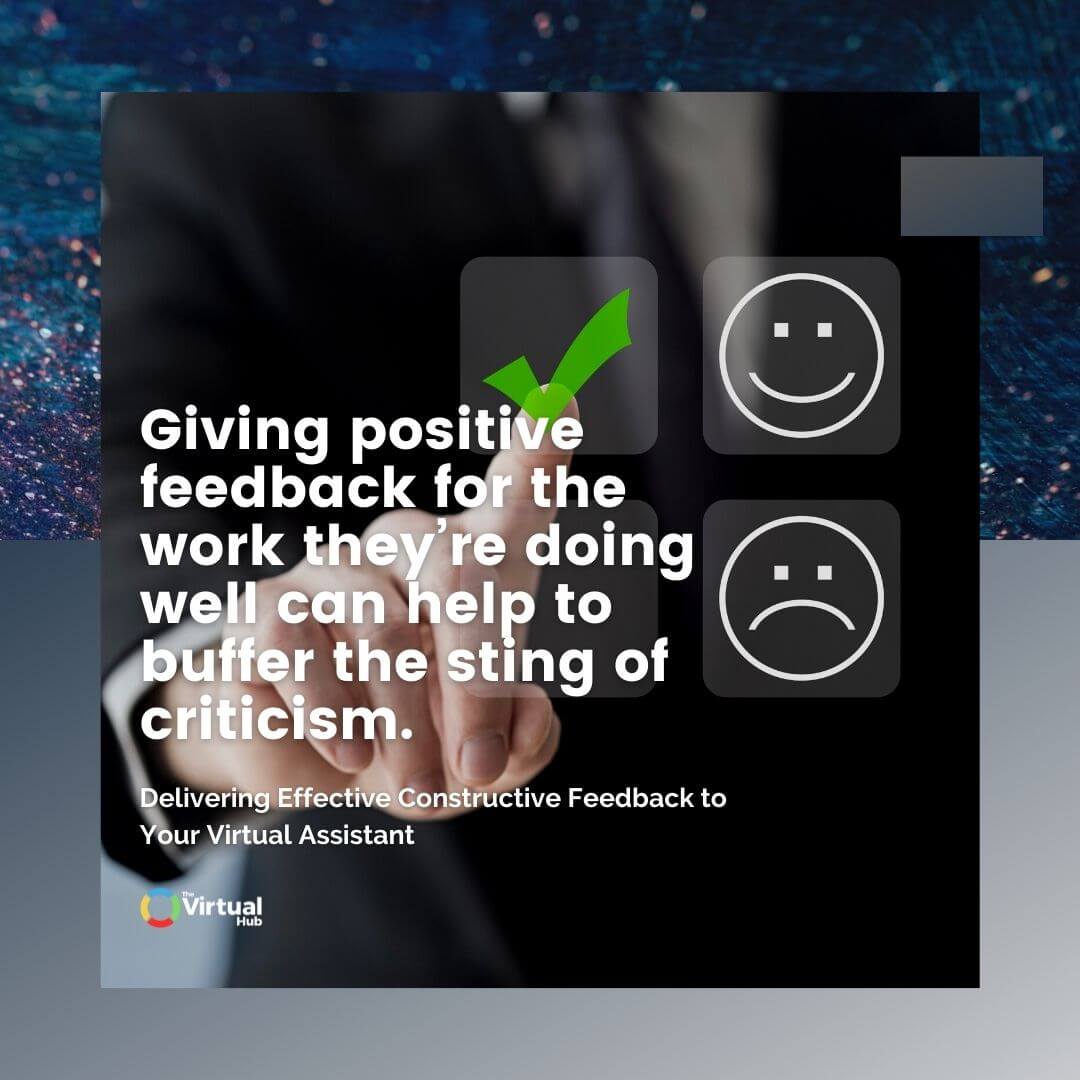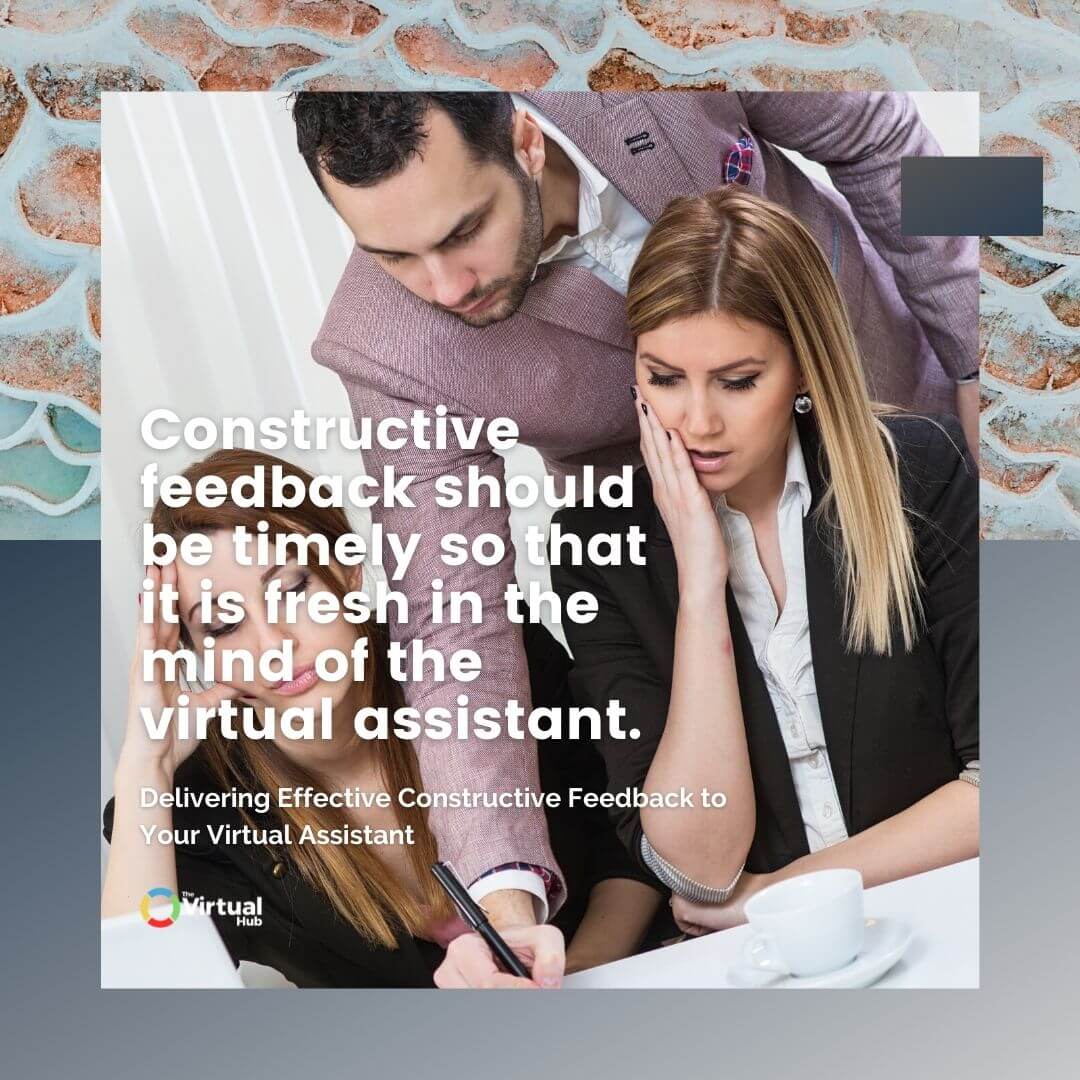Giving and receiving constructive feedback is part of a healthy working relationship with your remote employees.
Consider a time when you’ve ever received feedback at work. Was it received in-person, or via a remote means of communication? How did it come across to you?
The thing that makes a virtual environment unique is that any such constructive comment will almost always be communicated remotely. Because of this, sometimes, it’s hard to know how to give good virtual feedback.

When you’ve received constructive criticism in-person before, you’ve had all sorts of verbal and non verbal cues to help you understand the context of the feedback. You’re able to see body language and hear words and tone, and you can quickly ask clarifying questions. Usually, any kind of misunderstanding can be cleared up promptly.
Many people worry about giving feedback remotely while ensuring the message is received clearly, and preferably without coming across as a jerk. You want to promote good working relationships while getting the results you need. So, here are some tips on how you can provide feedback to your virtual assistants.
RELATED: 10 Best Productivity Apps For You And Your Virtual Assistant
How to Give Constructive Virtual Feedback to Your Virtual Teams | 9 Best Tips to Success
You can click on these links below to jump on a specific section:
What Are the Types of Feedback?
Feedback is essential for helping remote employees grow and improve in their roles. However, not all feedback is created equal.
Here are a few types of feedback you may find yourself giving to your team:
Positive Feedback
Sometimes called "encouragement," this type of feedback highlights what your remote team did well. It's useful for boosting confidence and motivating someone to keep up the good work.
Negative Feedback
This type of feedback focuses on what your virtual assistant did wrong and how they can improve. It's important to be clear, concise, and objective when delivering negative feedback.
Constructive Feedback
Constructive feedback is a mix of positive and negative feedback. It starts with something your virtual assistant did well, followed by an area of improvement. For instance, you may say, "You did a great job on this project, but next time I'd like to see you take more initiative."

What Are the Qualities of Effective Feedback?
If you've ever been on the receiving end of a feedback conversation, you know that it's not always effective. In fact, sometimes it can be downright destructive.
So how do you communicate effective feedback to your virtual assistant?
Be Constructive
The goal of feedback is to help your team member improve, so it should be constructive. This means that you should pay close attention to what your virtual assistant can do differently or better in the future, rather than dwelling on their past mistakes.
Be Timely
The sooner you give feedback, the better. If you wait too long, your remote teams, including your team leaders, may not remember what they did and they'll have a harder time implementing your suggestions.
Be Specific
Broad, general comments can be confusing and difficult to act on, whereas specific, data driven feedback can help your managers and team members understand what they need to work on and give them a tangible goal to strive for.
If you can, use examples to illustrate your point. For instance, rather than simply telling your colleagues that their work is sloppy, you could point out a specific instance where their work was not up to par.
Or, if you're giving feedback on a presentation, you could say something like, "I noticed that you didn't make eye contact with the audience very much. Next time, try to make sure that you look at each person in the room for at least a few seconds."
This type of specific feedback will help the person you're speaking to understand what they need to do differently next time, and it will help them feel more confident about their ability to improve.
Avoid Criticism
When you're having feedback sessions, avoid criticism. This is when you focus on the person's character, rather than their behavior. Rather than saying "you're lazy," try "I noticed that you didn't take initiative on this project."
RELATED: Hubspot Hacks Your Virtual Assistant Can Set Up To Streamline Your Business
Avoid Compliments
When giving positive feedback, avoid sounding like you're paying someone a compliment. For example, instead of saying "Good job," try "This is what I liked about your work."
Be Objective
It's important to be objective when giving feedback. This means avoiding any personal biases or opinions. For instance, if you don't like the way someone dresses, that shouldn't factor into your feedback about their work performance.
Focus on the Future
When giving feedback, explain what your colleagues can do in the future to improve. Instead of saying "You didn't do this," try "Next time, I'd like to see you do this."
Avoid Using "I" Statements
When you provide a comment, avoid using "I" statements. Instead of saying "I think you should..." try "It would be helpful if you..."
Seek Feedback Yourself
Before giving feedback to someone else, it's a good idea to seek feedback yourself. This will help you understand how the person receiving the feedback might feel, and it will also give you some practice in giving feedback.
How Should Virtual Feedback Be Delivered?
If you’ve ever misunderstood an email communication or had one of your own misunderstood, you will know that giving feedback to a team member in a virtual world can be fraught with potential pitfalls. In fact, there’s a strong suggestion that, like breaking up with someone via text message, constructive feedback should not be given by email or text.
Whether you agree with that assessment or not, it’s clear that tonal nuance is lacking in written communication.
For example, if someone were to say, “You need to learn how to…” in person, there’s a chance that it may be accepted with a neutral tone, or seen as friendly cajoling. When you read that as a typed sentence though, it appears to have quite a critical sting. Why is this?
Our brains tend to have a “negativity bias” which keeps us highly attuned to unpleasant news. This is thought to be due to our primitive need to protect ourselves from danger. Our tendency to remember the one bad thing that happened above several good things is a demonstration of this.

The lesson? We are hyper-sensitive to feedback, and a written message, no matter how innocuously intended, can put us on high alert. Before you know it, the situation has blown up, and someone thinks they’re on their last warning!
In saying that, if you only reserve phone or video call for “bad” things, your virtual assistant may view your request for a meeting with a sense of doom.
Our suggestion here is that phone or video call be regularly used for positive virtual feedback and general work conversations, not just the constructive criticism.

Additionally, when you're giving feedback over video calls, it's important to maintain eye contact with the person you're speaking to. Of course, this can be a little tricky, since you're not actually in the same room. But there are a few simple tricks that can help:
- Try to position your camera so that it's at eye level. This will help create the illusion of eye contact.
- Make sure to look directly into the camera when you're speaking.
- Don't be afraid to use facial expressions and gestures to emphasize your point.
By following these simple tips, you'll be able to give feedback in a virtual world that feels just as natural and personal as if you were right there in the room with the person you're speaking to.
How Often Should You Give Virtual Feedback?
There’s really no right or wrong answer here, but one thing that helps to get better results more quickly is by creating a feedback culture. This means that the idea of a virtual feedback conversation is ingrained—it is expected, and team members generally don’t feel nervous about it.
Provide timely feedback so that it is fresh in the mind of the virtual assistant. Saving up feedback until a quarterly review or something similar only stretches it out unnecessarily.

If you’re worried that you have too many things to give feedback on at once, perhaps pick out those that are the most crucial first. Consider what you’re really trying to achieve and what the key points are for getting there. You can always update your process documentation to cover more minor items as well.
How Should Virtual Feedback Be Followed Up?
A key part of delivering critical virtual feedback effectively is to ensure that it is taken onboard, with some process or mechanism for following up afterwards.
This is not to suggest that you become a “helicopter” boss. In fact, this is an ineffective use of both your and your virtual assistant’s time. If they’re constantly responding to status update requests, when are they getting actual work done?
One thing you can do is to invite two-way communication.

Speak to your virtual assistant about what needs to happen and ask for their input on the best way to ensure it gets done. Whether this involves adding something to a procedure or getting a certain tool to help, getting their input helps with buy-in.
Check in with the virtual assistant once they’ve had a chance to correct whatever it was that you gave constructive virtual feedback about. How did they manage the change? Is there anything else they need to make it happen?
By encouraging employees to share ideas and giving them the opportunity to provide feedback as well, organizations can create a workplace that nurtures growth and support. Furthermore, a feedback culture can help to identify problems early on and prevent them from becoming bigger issues.
Final Thoughts
Providing feedback goes hand-in-hand with having team members in your organization. Your virtual assistant is there to help navigate the critical tasks and remote work of your business, but the chances are they may need some critical feedback at some point.
Know your audience first and understand what might make constructive feedback more effective for them. Sometimes, there may be cultural nuances that are worth understanding before barrelling in with a very direct response.
In that same vein, avoid simply “reacting” to circumstances. Take a breath and consider your approach so that you are able to keep it professional. Developing an understanding and a company culture that embraces virtual feedback can help build trust in your workplace and help you establish a more meaningful connection with your virtual assistant.
Additionally, by setting expectations and providing specific, actionable feedback, business owners and managers can help their employees become more efficient.
Have more questions about virtual assistants in general? Our Ultimate Guide to Virtual Assistants can answer all of those and more! This guide is the only one on the internet that will break down everything you need to know about virtual assistants and how to leverage them to grow your business and get you out of overwhelm.
